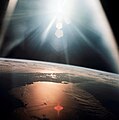Apollo 7
| COSPAR ID | 1968-089A |
|---|---|
| SATCAT no. | 03486 |
| Crew | |
| Members | 3 |
 File:GPN-2000-001160.jpg
File:GPN-2000-001160.jpg | |
Apollo 7 was the first manned mission in the Apollo program to be launched. It was an eleven-day earth-orbital mission, the first manned launch of the Saturn IB launch vehicle, and the first three-man American space mission.
Crew
- Walter M. Schirra (3), commander
- Donn F. Eisele (1), command module pilot
- Walter Cunningham (1), lunar module pilot
This crew was originally the backup crew of the ill-fated Apollo 1.
*Number in parentheses indicates number of spaceflights by each individual, prior to and including this mission.
Backup Crew
- Tom Stafford (flew on Gemini 6A, Gemini 9A, Apollo 10, Apollo-Soyuz), commander
- John Young (flew on Gemini 3, Gemini 10, Apollo 10, Apollo 16, STS-1, STS-9), command module pilot
- Eugene Cernan (flew on Gemini 9A, Apollo 10, Apollo 17), lunar module pilot
Support Crew
- Ronald Evans (flew on Apollo 17)
- Ed Givens (never flew in space due to being killed in a car accident)
- Jack Swigert (flew on Apollo 13)
- Bill Pogue (flew on Skylab 4)
Flight directors
- Glynn Lunney (Lead), Black team
- Gene Kranz, White team
- Gerald Griffin, Gold team
Mission highlights
Apollo 7 was a confidence-builder. After the January 1967 Apollo launch pad fire, the Apollo command module had been extensively redesigned. Schirra, who would be the only astronaut to fly Mercury, Gemini and Apollo missions, commanded this Earth-orbital shakedown of the command and service modules. Since it was not carrying a lunar module, Apollo 7 could be launched with the Saturn IB booster rather than the much larger and more powerful Saturn V. Schirra wanted to give Apollo 7 the callsign "Phoenix" (the mythical bird rising from its own ashes) in memory to the loss of the Apollo 1 crew, but NASA higher-ups nixed that idea; fearing public backlash.
The Apollo hardware and all mission operations worked without any significant problems, and the Service Propulsion System (SPS), the all-important engine that would place Apollo in and out of lunar orbit, made eight nearly perfect firings. Even though Apollo's larger cabin was more comfortable than Gemini's, eleven days in orbit took its toll on the astronauts. The food was bad, and all three developed colds. As a result Schirra became irritable with requests from Mission Control and all three began "talking back" to the Capcom, leading to none of the crew being selected for further missions. But the mission successfully proved the space-worthiness of the basic Apollo vehicle.
Goals for the mission included the first live television broadcast from an American spacecraft (Gordon Cooper had broadcast slow scan television pictures from Faith 7 in 1963) and testing the lunar module docking maneuver.
First orbit: Perigee 231 km, Apogee 297 km, Period 89.78 min, Inclination 31.63 deg. Weight: C/SM 14,781 kg.
The splashdown point was 27 deg 32 min N, 64 deg 04 min W, 200 nautical miles (370 km) SSW of Bermuda and 13 km (8 mi) north of the recovery ship USS Essex.

For nearly 30 years the Apollo 7 module was on loan (renewable every two years) to the National Museum of Science and Technology of Canada, in Ottawa, along with the space suit worn by Wally Schirra. In November 2003 the Smithsonian Institution in Washington D.C. requested them back for display at their new annex at the Steven F. Udvar-Hazy Center. Currently, the Apollo 7 CM is on loan to the Frontiers of Flight Museum located next to Love Field in Dallas, Texas.
Apollo 7 was the only manned Apollo launch to take place from Cape Canaveral Air Force Station's Launch Complex 34, as all subsequent Apollo (including Apollo-Soyuz) and Skylab missions were launched from Launch Complex 39 at the nearby Kennedy Space Center.
As of 2007, Cunningham is the only surviving member of the crew - Eisele died in 1987, and Schirra in 2007.
Mission insignia
The insignia for the flight showed a command and service module with its SPS engine firing, the trail from that fire encircling a globe and extending past the edges of the patch symbolizing the Earth-orbital nature of the mission. The Roman numeral VII appears in the South Pacific Ocean and the crew's names appears on a wide black arc at the bottom.
Depiction in fiction
Portions of the Apollo 7 mission are dramatized in the miniseries From the Earth to the Moon episode entitled "We Have Cleared the Tower".
References
- NASA NSSDC Master Catalog
- APOLLO BY THE NUMBERS: A Statistical Reference by Richard W. Orloff (NASA)
- Lattimer, Dick (1985). All We Did was Fly to the Moon. Whispering Eagle Press. ISBN 0-9611228-0-3.
- Schirra, Wally with Richard Billings (1988) . Schirra's Space. Naval Institute Press. ISBN 1-55750-792-9.
Pictures
-
Apollo 7 launch (NASA)
-
Apollo 7 launch (NASA)
-
Apollo 7 SIV-B rocket stage (NASA)
-
Apollo 7 view of Florida. (NASA)



